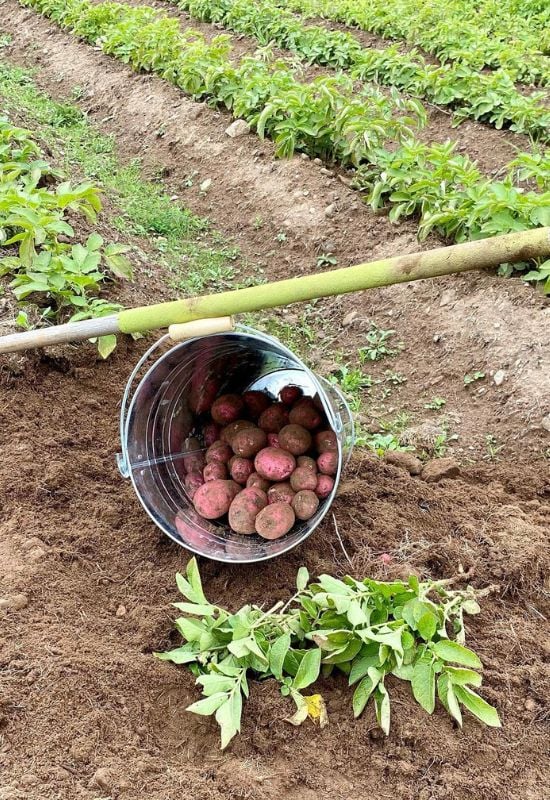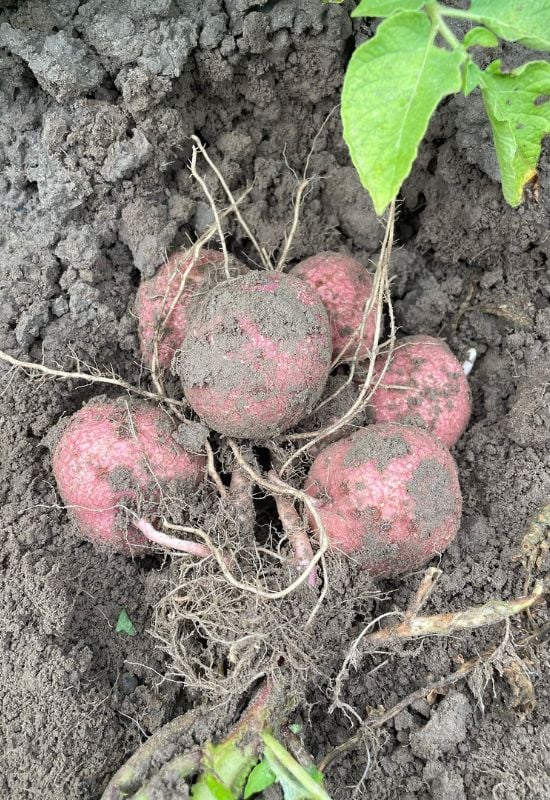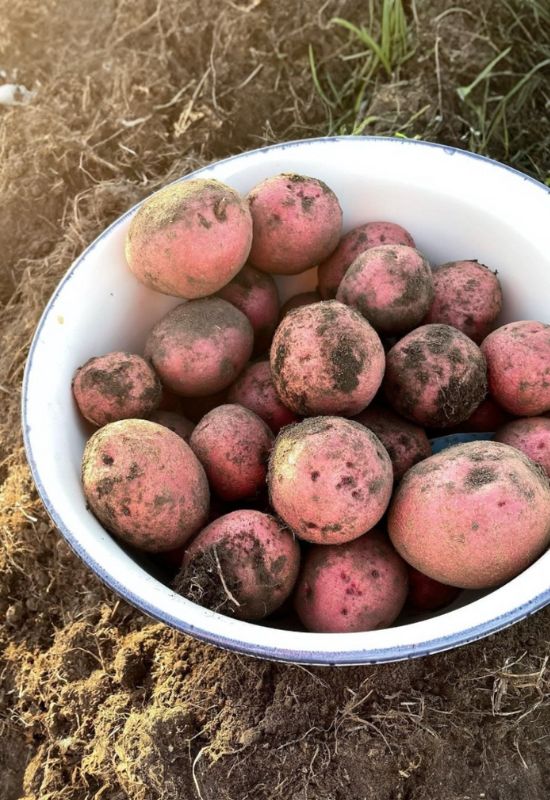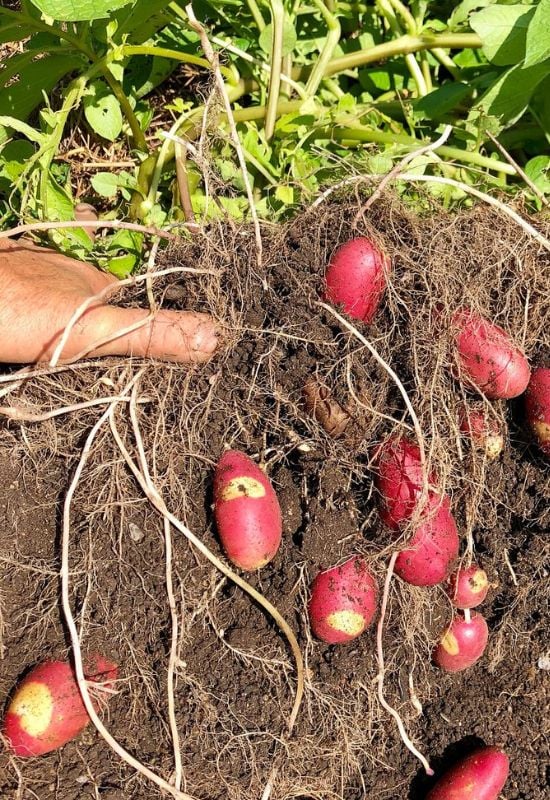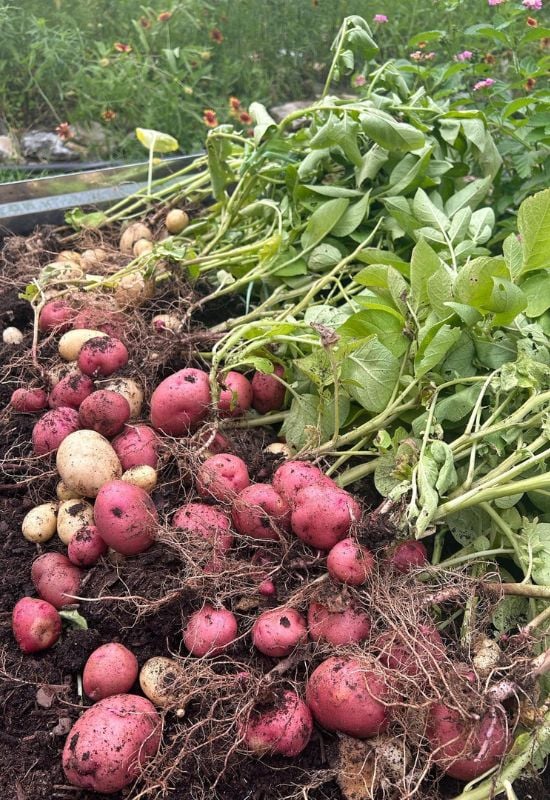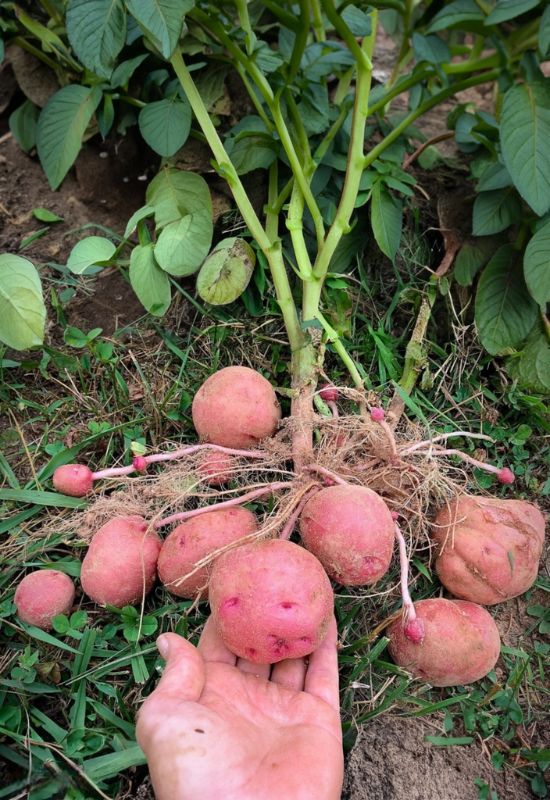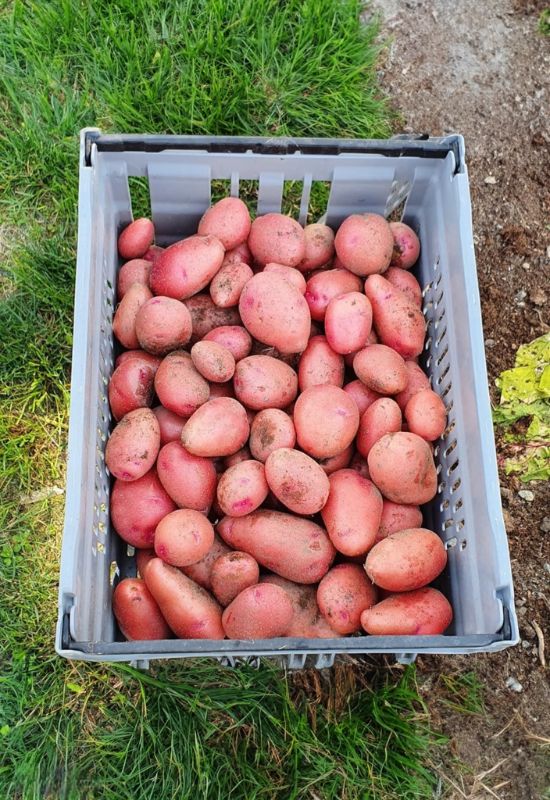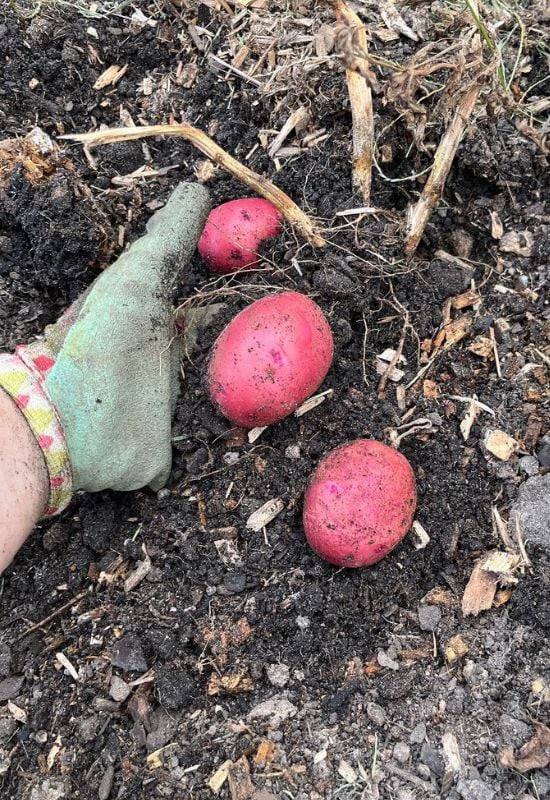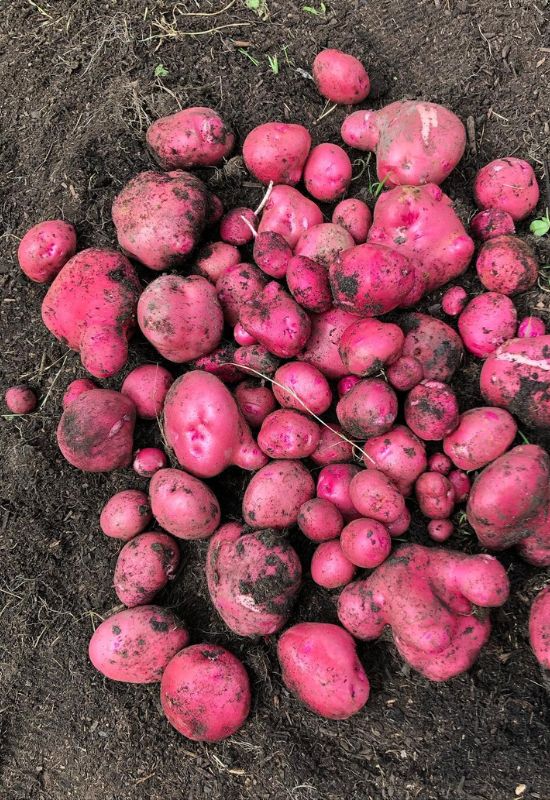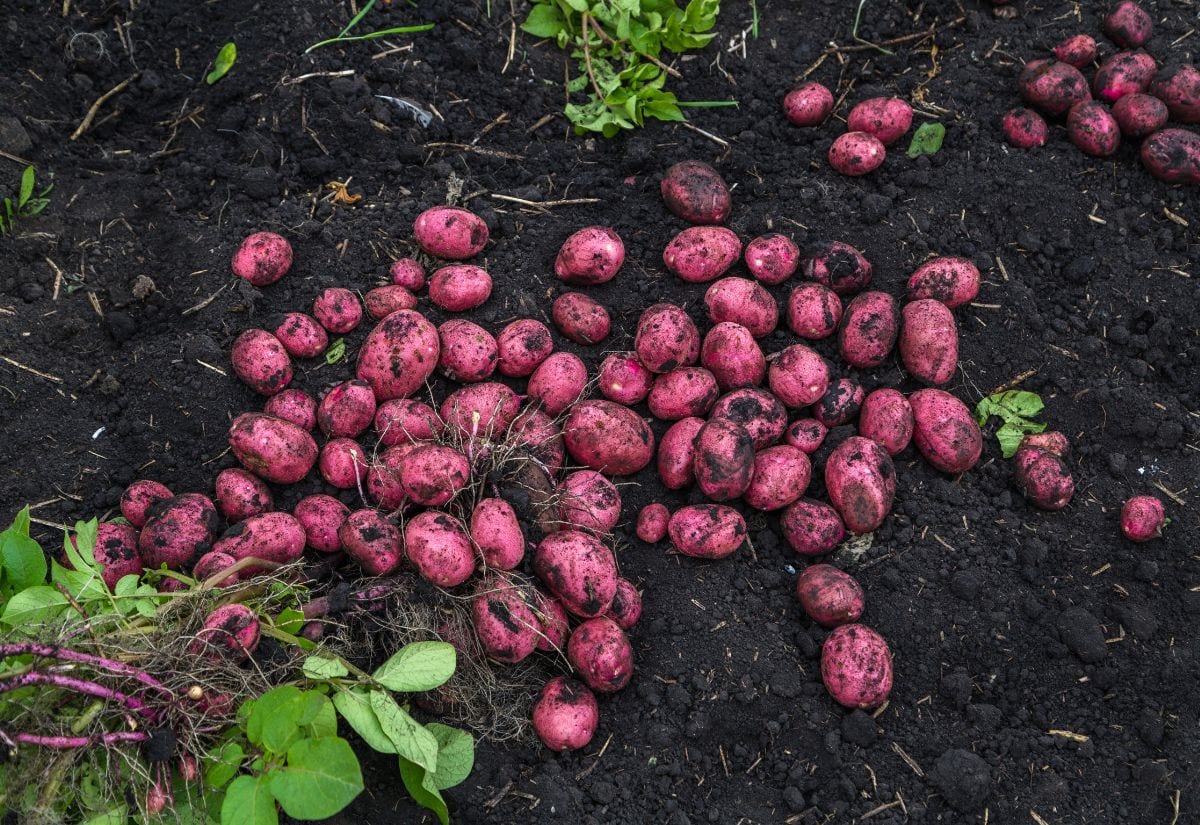
In any grocery store I visit, I typically find three main types of potatoes: red, yellow, and russet. But if you’re a fan of red potatoes like I am, you know that there are hundreds of varieties sporting a red skin over the creamy insides. While red potatoes may all look the same at a glance, each has its own unique color, flavor, and culinary purpose.
But how do you know which variety of red potato to choose? And how should you care for them in your garden?
Keep reading, as I guide you through the process of planting, growing, and harvesting red potatoes, and introduce you to my top 16 picks of potato cultivars with red skin.
All About Red Potatoes
Red potatoes have reddish skin (ranging sometimes from dark pink to light purplish), and white to yellow coloured insides. They stand out amongst their pale-skinned cousins and for good reason: due to their dark skins, red potatoes are one of the healthiest and most nutritious potatoes out there.
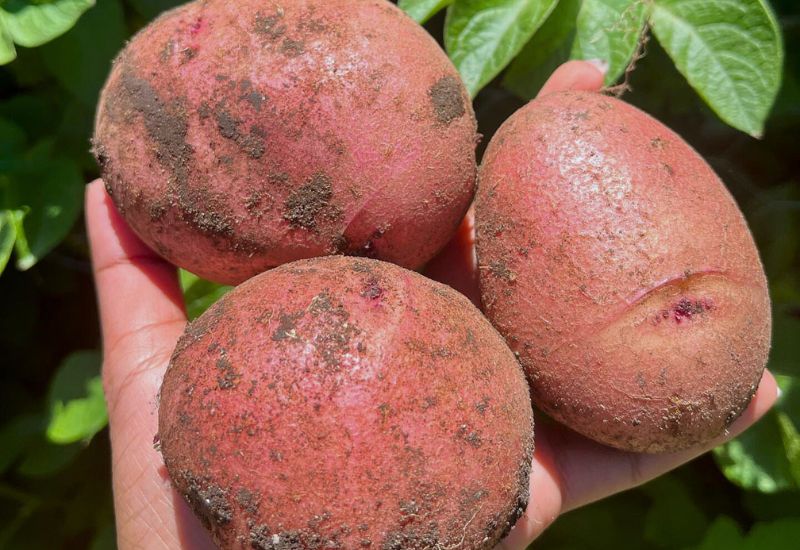
Red potatoes are rich in vitamin B6 and vitamin C, and they also contain some potassium and iron. They are also rich in antioxidants, thanks to large quantities of the anthocyanain pigment in the skin.
As the name suggests, red potatoes have thin, rouge skin that is generally shiny and smooth and does not require peeling.
Most of the nutrition is found in these red skins, and you can safely eat potato skins in most cases. However, do not eat the skins on potatoes that are damaged, sprouted, or turning green as they contain poisonous substances that can be very unhealthy in large quantities, especially to children.
In most cases, you can eat skins in moderation but, with or without skin, red potatoes are a great addition to your meals and you will be very happy you grew them in your garden.
On the inside, red potatoes are (usually) white, cream, or yellow.
The flesh is dense and creamy when cooked with a mild buttery flavour that is slightly sweet (they are considered a medium sugar content potato).
Red potatoes are called a waxy potato which means they have less start and hold their shape better when cooked. In fact, red potato are probably the waxiest of all the potato types and they are excellently suited for salads, soups, roasting, boiling, or mashing.
Red potatoes are considered a small to medium potato depending on the variety. They typically weigh between 140 and 180g (5-10 oz), and have a round to oval shape with a diameter of around 3.5cm to 6cm (1.5-2.5 inches).
Planting Red Potatoes
Here is a guide to planting red potatoes in your field or garden:

Red potatoes grow best in loose, well-drained soil with a pH between 6.0 and 7.0. Being heavy feeders, they grow especially well in plots that were enriched with compost just before planting.
Sprout your seed potatoes prior to planting by placing the tubers in a sunny spot (but out of direct sunlight) 20 days or so before you want to plant. Each seed potato should have between 2 and 4 eyes if possible, and you can cut any large ones if needed.
Seed potatoes can be surprisingly small, with most companies recommending a seed potato that is 2cm to 4cm (1-1.5 inches) in diameter, or weighs roughly 85g (3oz). Of course, they can be larger and you will still get a great crop of red potatoes in the fall.
Start red potatoes in your garden between 2 and 4 weeks before your last expected frost. Dig a small hole 8cm (3 inches) deep, set your seed potato in the bottom, and cover them with soil again. Most varieties of red potato can be spaced 30cm (12 inches) apart in rows set 60cm to 90cm (24-36 inches). You should begin to see the plants popping up in around 2 weeks.
Alternatively, you can grow potatoes from seed (as opposed to seed potatoes) by following these tips here.
Care While Growing
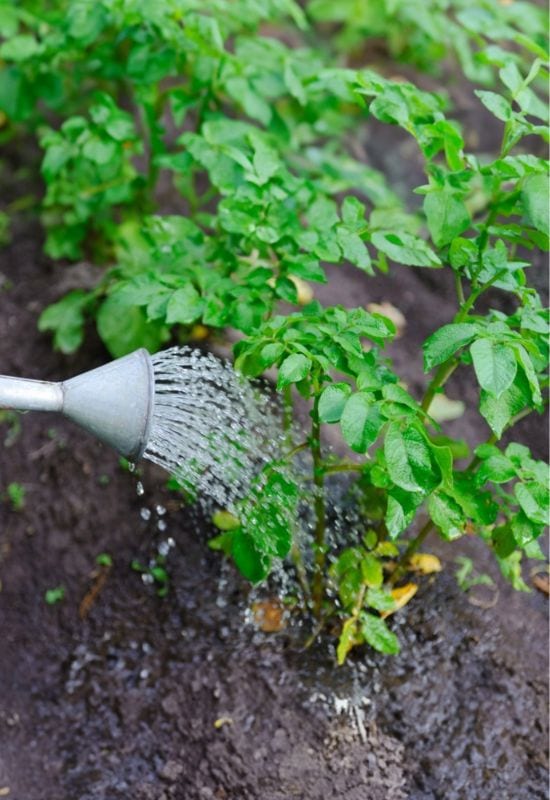
While growing, red potatoes really only need two things: watering and hilling.
Watering: For the best shaped tubers and an abundant harvest, give your red potatoes 2cm to 3cm (approximately 1 inch) of water every week. Hopefully, you will get adequate rainfall, but make sure to turn on the water if not. Soaker hoses work exceptionally well for potatoes by providing moisture directly to the roots and developing tubers.
Hilling: Hilling is the practice of covering your growing potatoes with soil, compost, straw, or another organic matter. The main purpose of hilling is threefold: it protects tubers from greening in the sun or being damaged by the frost; it suppresses weeds; and it gives you a bigger yield of better tubers. Hilling is not necessary, but it can certainly help your crop. When the plants are between 15cm to 30cm (6-12 inches) tall, mound up your chosen matter around the base of the plant, and repeat once or twice more throughout the growing season.
How And When To Harvest Red Potatoes
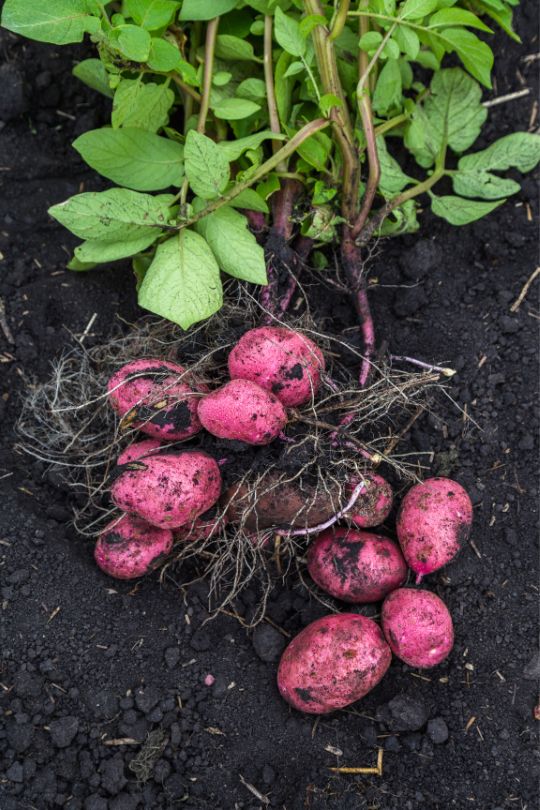
Regardless of which variety you grow, your red potatoes can be harvested at any point. It is popular to dig them small as creamers or “new potatoes”, or leave them in the ground until they have reached their maturity date as full sized potatoes.
Most red potatoes are full size in the late summer or fall. Leave them in the ground until two weeks after the foliage has died back, or until a killing frost hits your area. Check out our other article for more tips on when and how to harvest potatoes.
Storing Red Potatoes
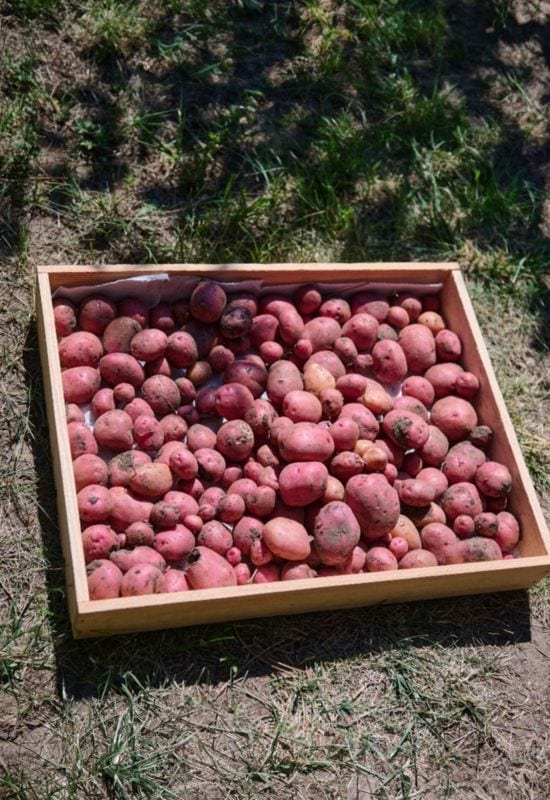
If possible, let your potatoes cure for 7 to 14 days after harvest. Lay them in a single layer in a cool, dark location with good air circulation. (Note: this step isn’t necessary, but it can improve the long-term storability of the red potatoes).
There are many different ways to store potatoes. My favorite way is to put them in a cardboard box (punch a few air holes), and cover them with paper shavings (this is a great way to get a second use out of old bank statements).
Keep them at 7C to 10C (45-50F) for ideal storage. If long term storage for commercial purposes is required, maintain a 95% relative humidity.
16 Red-Skinned Potato Varieties You’ll Love to Grow
Now that you know how to grow red potatoes, it is time to choose the best variety for your garden (and palette). You can’t go wrong by choosing one of these favorite red potato varieties:
Adirondack Red
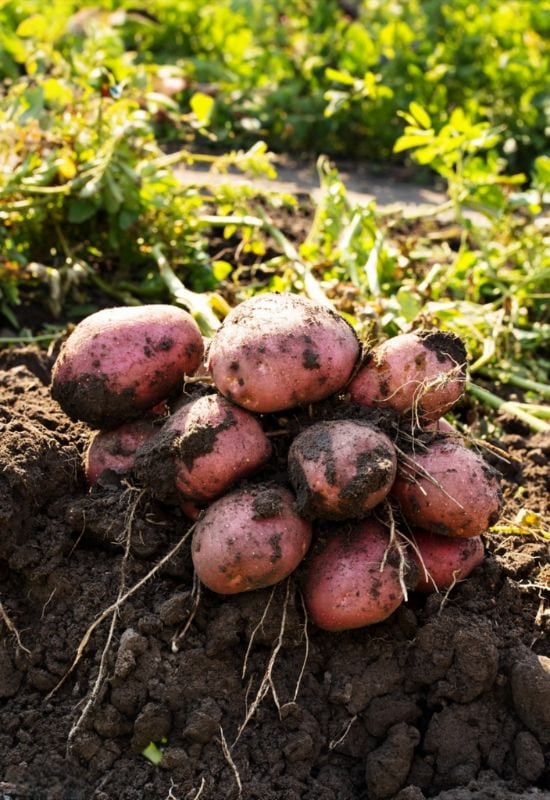
Adirondack potatoes are mostly well known as the old blue or purple variants, but the Adirondack Red came on the scene in 2004.
Unlike most red potatoes, the insides of Adirondack potatoes are red which means the flesh is also high in antioxidants. In fact, the skin can range from red to reddish-purple, and the flesh can be from pink to red in colour.
Developed by Cornell University, Adirondack Red are fairly sprawling plants with a medium to high yield of long and slightly flattened tubers.
Adirondack Red potatoes are susceptible to silver scurf disease and golden nematodes. On the other hand, the are fairly resistant to common scab and they produce nice, blemish-free tubers on the whole.
2: Chieftain
Since 1957, Chieftain potatoes have become a fairly popular red potato for home gardeners, market gardeners, and large export growers, and it is easy to see why.
This medium sized plant sports large, pale purple flowers and lots of oval tubers. The red skin is very bright and attractive, with slightly darker spots at the eyes. The flesh is white and they are excellent for boiling, roasting, frying, salads, and any other potato recipe you have. Chieftain potatoes also store very well, and can even respond well to being washed before storage.
Another attractive quality is that they are widely adaptable and can be grown in a wide range of conditions and soil types. Just be sure to keep them well watered for good sized potatoes as a lack of watering will lead them to be undersized.
Chieftain have resistance against late blight, common scab, rhizoctonia, silver scurf, stem-end browning, tuber net necrosis, and verticillium wilt.
They are susceptible to black leg, fusarium dry rot, leaf roll, phoma rot, PVX, and PVY.
3: Cherry Red
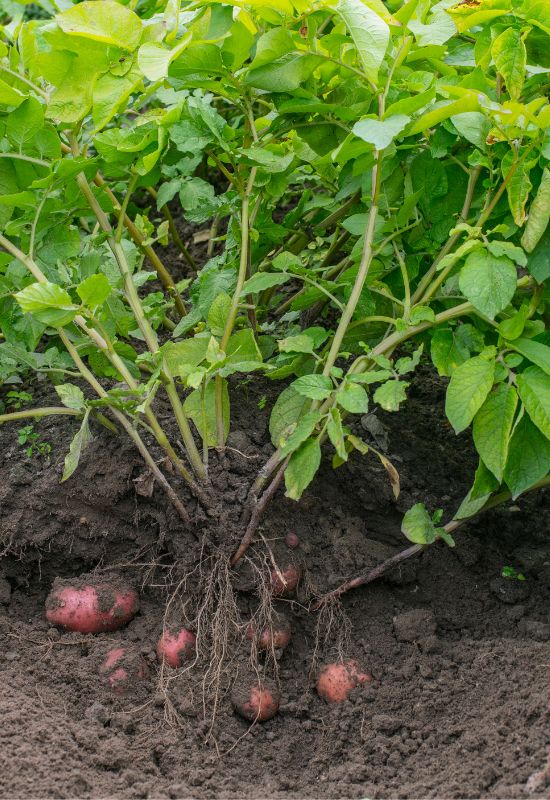
From 1999, Cherry Red potatoes produce lots of pretty flowers with a blue-violet corolla and prominent star. They are a medium sized, semi erect plant that has fairly good drought tolerance, plus they are resistant to fusarium dry rot, rhizoctonia, and hollow heart. Cherry Red can have problems with early blight (both tuber and foliar), common scab, blackleg, leafroll, PVY, PVX, powdery scab, and bacterial soft rot.
It is a good yielding crop, consistently producing 8 to 9 tubers under each plant. The oval potatoes have a smooth red skin and white flesh that are excellent for boiling and baking but work well for everything else, too.
The plant starts developing tubers early and they bulk up quite quickly, promising an early harvest. Because of the fast tuber set and development, the potatoes can grow quite large, so check them early to avoid cracking.
Red Cherry also sets its tubers quite shallow, so hilling is important to protect them from the sun.
4: Desiree
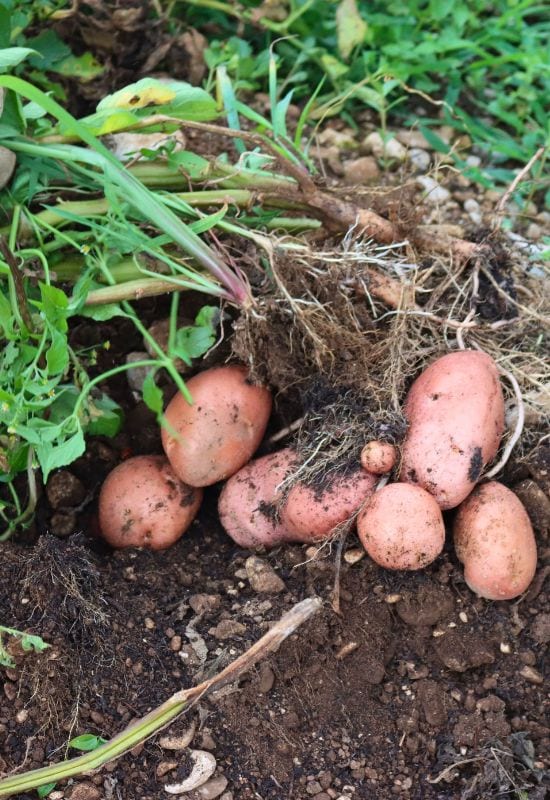
This mid to late season variety from 1951 is a highly sought after potato, and is commonly sold in natural grocery stores. It is also popular with lots of gardeners.
Desiree are a high yielding variety with light yellow insides, which are superb for boiling but also works well fried, baked, or turned into potato salad or potato chips.
The plants are fairly short but sprawling plants with thick stems. It produces numerous pink flowers with white tips and a pretty green star pattern.
The tubers are also very nice looking. Desiree potatoes are medium to large long oval tubers with a smooth red skin. Despite their large size, Desiree potatoes rarely crack nor suffer from hollow heart. They have a nice uniform size, though irregularly shaped spuds can occur in heavy soils or when given e
Desiree potatoes tolerate drought quite well, and they also have a good disease resistance package, including skin spot, PVY, tuber late blight, blackleg, PVA, PVX, fusarium dry rot, and they are immune to potato wart (race 1). The only real issue they face is common scab, but you should also watch out for leaf late blight, and leaf roll.
5: Glenwood Red
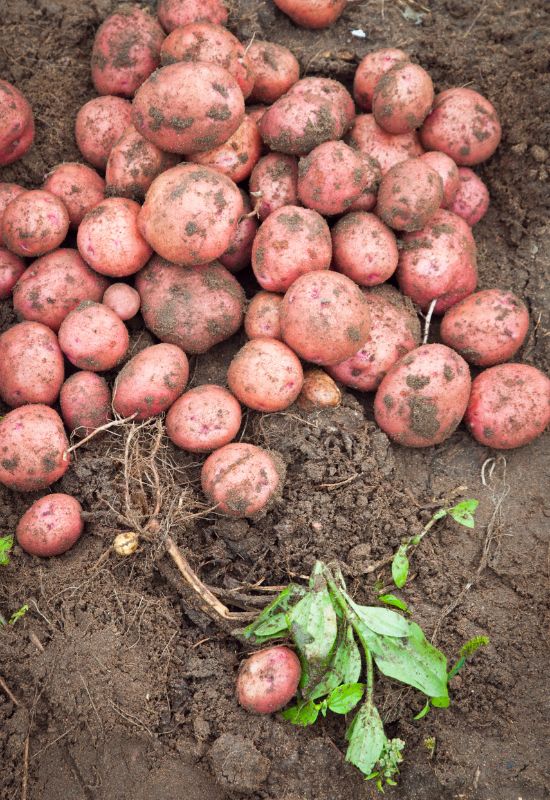
Hailing from Newfounfland, Canada in 1991, this late season, medium sized plant produces lots of red-violet flowers. The tubers are round with a smooth light pink skin and white to cream coloured flesh.
Each plant produces lots of tubers that are a nice, uniform size. They are predominantly used for boiling and baking, but they are well adapted to many dishes.
Glenwood Red are resistant to potato wart, late blight, common scab, and fusarium dry rot. They are susceptible to golden nematode.
If you live in Newfoundland, or another east coast place with a similar climate, you will find that these potatoes really shine.
6: Lady Rosetta
Lady Rosetta came out of Holland in 1988. They are a medium to late season variety of red potato that produces tall plants. The flowers are noteworthy: not only are there lots of them, but they are a pretty mauve with a striking white start pattern. (Some mutants have been noted that have all white blooms or even white potatoes). Another interesting point about Lady Rossetta’s flowers is that they produce very little, if any, berries!
Lady Rosetta tubers are round with flaky red skin, and each plant produces very attractive and uniform potatoes.
The plants are very prolific and you will harvest great tasting potatoes with cream to pale yellow flesh that are particularly ideal for boiling or backing as the suffer almost no discolouration after cooking.
They are resistant to PVA, PVX, potato cyst nematode, PVY, leaf roll, common scab, and tuber blight. Lady Rosetta do have problems with blackleg, powdery scab, and leaf blight.
7: Norland
In my area, Norland potatoes are possibly the most common locally grown red potato, and they have been sought after by commercial growers and home gardeners since they came out in 1951. The purple flowers are very pretty but the spuds themselves are even more exceptional.
This early season variety quickly produces lots of oblong, slightly flattened tubers with a smooth red skin. They are smallish, and the potatoes fit nicely in your hand. A few strains, such as Norland Dark Red, Red Norland, New Red Norland have even darker-toned skin but they all have a bright white flesh.
An attractive characteristic of the Norland potato is that they are adapted to most every garden soil and climate. They are, however, sensitive to drought-like conditions so monitor your watering closely.
They are excellent young potatoes, though they bruise and skis easily when harvested early. But they wash and store very well when left to mature, and since they are an early variety, you don’t have too long to wait!
Norland have very little issue with internal defects, and they are resistant to PVA, common scab, potato wart, and rhizoctonia. They are highly susceptible to silvery scurf and also be on the lookout for black leg, fusarium dry rot, late blight, leaf roll, phoma rot, and verticillium wilt.
In the kitchen, Norland potatoes are good for pretty much any potato dish you want to create.
8: Pinto Gold
A more unique red potato, Pinto Gold is a relatively new potato that was officially made its start in 2018. It was bred by the University of Maine and has a very high yield and stores well.
Pinto Gold has a yellow flesh that is buttery and very delicious, but it is in the skins that these potatoes really shine. The skin is smooth and red with large yellow patches around the eyes, giving the potatoes a nice patchwork look. The size is very irregular but, and you can get ovals or even long fingerlings, but this only adds to their charm.
They are a late season variety and have a fairly acceptable disease resistance package.
9: Red Gold
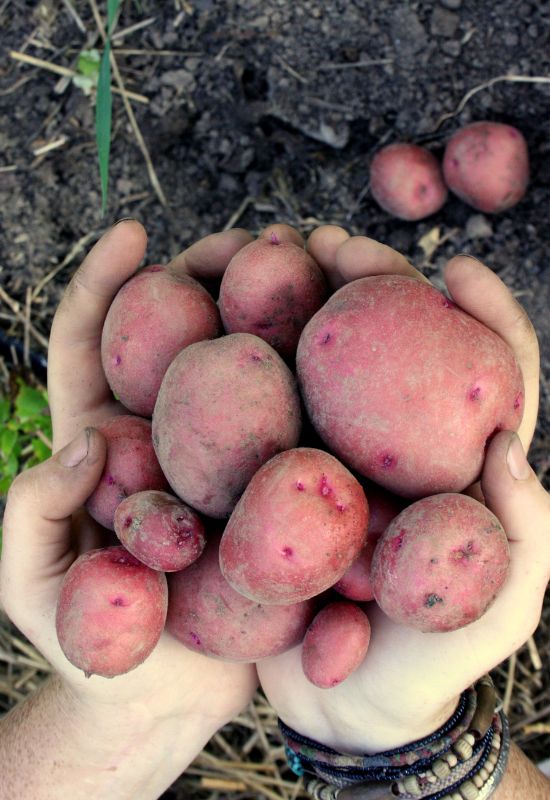
The name “Red Gold” adeptly explains the contrast between the skin and the flesh. Coming out in 1970, they are a mid season variety that are a decent producer of delicious tubers.
The potatoes are round to oval, with a smooth to slightly flaky pinkish-red skin, and the eyes are marked by brighter pink-red spots.
The bright yellow flesh has a very moist texture, making them excellent for boiling and baking.
Red Gold are resistant to leaf roll, PVA, and common scab, but susceptible to PVA, PVS, and PVX.
And the flowers are an electric pinkish-purple!
10: Red La Soda
Red La Soda came about in the mid 1900s. This mid-season variety is an average side plant with large lavender coloured flowers.
It has elliptical, very attractive looking tubers with a deep red skin. They also store very well.
Each plant yields a lot of potatoes and the flesh is white and they are good for baking, boiling, and roasting.
Red La Soda grow well in all climates and are grown from the north to the south. They are particular good in hot and dry seasons and they are also resistant to early blight. Be on the lookout for black leg, common scab, fusarium dry rot, late blight, leaf roll, verticillium wilt, PVX, and PVY as Red La Soda are susceptible to these.
11: Red Pontiac
This is one of the most popular red potatoes the world over. Registered in 1931, Red Pontiac potatoes are a mid to late season variety. The plants are very large, matched by large, white-tipped purple blooms.
The tubers themselves are mostly round or slightly oblong with smooth, occasionally netted red skin. The plants produce lots of these very attractive potatoes. They are also tolerant to drought. On top of that, they store very well but bruise easily to handle them carefully at harvest.
They are moderately resistant to tuber net necrosis and black leg, but they are susceptible to PVA, PVX, PVY, leaf roll, common scab, fusarium dry rot, late blight, and verticillium wilt.
The white-fleshed potatoes can be cooked and prepared in any way for a delicious meal.
12: Redsen
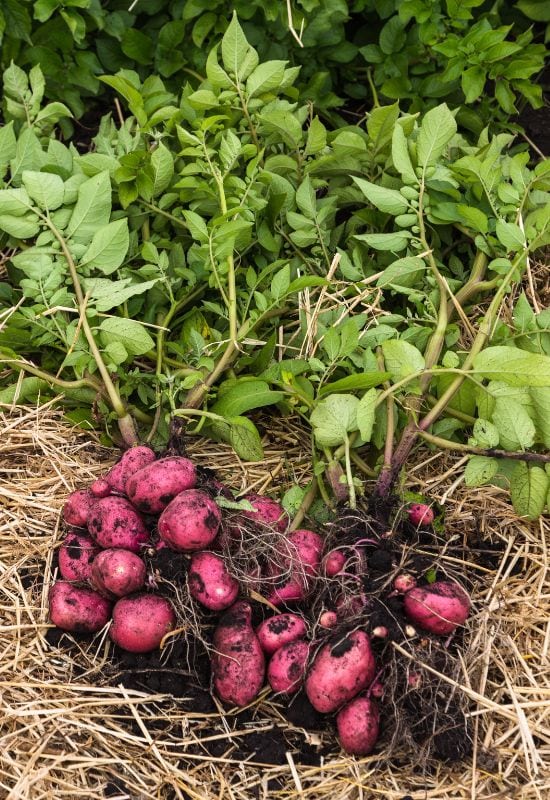
Redsen potatoes were released in 1983 from North Dakota, and are an early to medium season variety. The plants are fairly large and have pretty lavender coloured flowers.
Redsen tubers are fairly round, with bright red skin that is very thin and smooth, and white insides. The plants yield quite well and don’t usually have issues with internal defects. Harvest them carefully, however, as the thin skins bruise very easily.
Mostly bred for baking and roasting, these potatoes boil well but are susceptible to blackening afterward, especially if they have been stored for a long time first.
They are resistant to late blight, common scab, and silver scurf, but they can have problems with fusarium dry rot.
13: Rosara
Rosara potatoes came out of Germany in 1983. They are a mid season variety with tall plants and red-violet flowers with a slight start pattern. The are bred to grow in every soil type and all growing conditions. They are not drought tolerant, however, so make sure to water them regularly.
The tubers are long ovals with smooth red skin. They are medium sized and very attractive. Thankfully, they do not have many issues with internal or external damage, such as bruising or hollow heart. Rosara are immune to potato wart, and resistant to golden nematode, tuber late blight, blackleg, common scab, leaf roll, PVA, PVY, and leaf late blight.
Their yellow flesh is perfect for boiling or baking.
14: Sangre
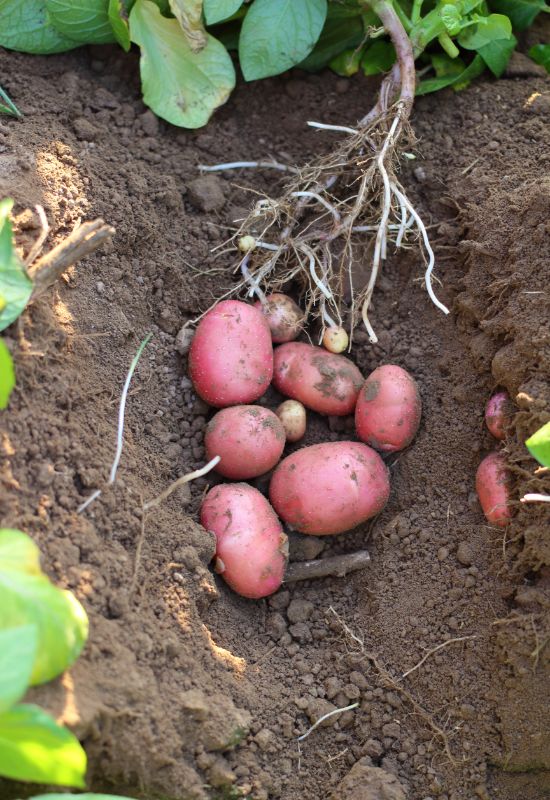
This mid season variety came out in 1982, with medium sized plants and a few lavender coloured flowers. They yield lots of oval tubers with smooth, deep red skin. Let the seed potatoes warm up to room temp for 7-10 days before planting for good emergence. They still might take a while to come up but grow very fast after that. The tubers can grow quite large, so plant them close together, at most 30cm (12 inches), to keep the tubers from growing too big.
Sangre are moderately tolerant to drought, but they perform far better with regular irrigation. Dry soil will lead to netting on the skin (this won’t affect the potatoes but they won’t be as pretty looking).
The white flesh has a great flavour that can be used in any way but they are excellent for boiling (with no after-cooking discolouration) and baking.
They are resistant to net necrosis, leaf roll, PVY, and early blight tuber rot. Sangre are susceptible to common scab, early blight, late blight, verticillium wilt, blackleg, seed-piece decay, and silver scurf.
15: Strawberry Paw
Possibly the most adorably-named potato, Strawberry Paw produces lots of round to oblong spuds. They are a mid season variety and the potatoes are generally fairly large with a bright red skin.
Their white flesh is very smooth and creamy with superb flavour. Strawberry Paw are quite moist and work well boiled, baked, roasted, or made into a salad.
Strawberry Paw are resistant to tuber late blight, common scab, which is what they were bred for. They are also exceptional storers and will keep all winter long.
16: Viking
Another very commonly grown potato, Viking came out in 1954 from North Dakota. There are light pink flowers on top of medium sized plants. They are a mid-season variety and are capable of producing a decent harvest in as little as 85 days.
Since the tubers size up quite quickly, space the plants 16cm to 20cm (6-8 inches) apart to avoid oversized, unshapely tubers. Viking are quite tolerant to drought, and will handle a wide range of climates and weather.
Viking plants high yielding, and produce lots of round to oblong smooth red skin. The bright white insides are ideally for boiling but are also good for baking, roasting, and salads.
They are fairly good at resisting common scab, but they have problems with black leg, fusarium dry rot, late blight, leaf roll, and verticillium wilt.
Other Red Potatoes
Of course, there are many, many more types of red potatoes. Some more notable varieties include Colorado Rose, Dakota Rose, La Rouge, Mountain Rose, NorDonna, Red Bliss, Red Luna, Red Maria, and Red Ruby.
There are also a few red fingerling potatoes, and while there can be a great and heated debate amongst horticulturalists whether they are fingerlings with red skins, or red potatoes with fingerling shape, it doesn’t make any difference to the dedicated red potato lover, so check out Red Thumb or French Fingerling.
The Colorful World of Red Potatoes
Red potatoes are one of my favorites. I really like the texture when cooked, and they are a colourful surprise when digging them up from the garden (and I don’t mistake them for rocks like I do with yellow-skinned varieties).
I hope this article has inspired you to try red potatoes in your own garden. What is your favorite kind of red potato to grow?

Written By
Amber Noyes
Amber Noyes was born and raised in a suburban California town, San Mateo. She holds a master’s degree in horticulture from the University of California as well as a BS in Biology from the University of San Francisco. With experience working on an organic farm, water conservation research, farmers’ markets, and plant nursery, she understands what makes plants thrive and how we can better understand the connection between microclimate and plant health. When she’s not on the land, Amber loves informing people of new ideas/things related to gardening, especially organic gardening, houseplants, and growing plants in a small space.

